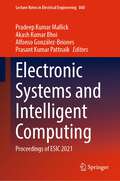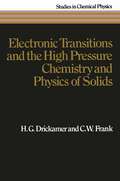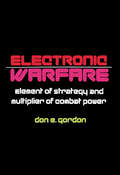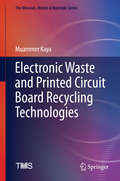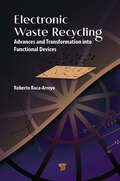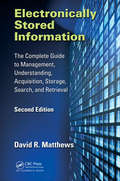- Table View
- List View
Electronic Structure of Rare-Earth Nickelates from First-Principles (Springer Theses)
by Harrison LaBollitaThis thesis demonstrates the value of theoretical approaches in the discovery of new superconducting materials. It reports a detailed study of the recently discovered nickel-oxide (nickelate) superconductors using multiple first-principles computational tools, from density functional theory to dynamical mean field theory. In the context of superconductivity, discoveries have generally been linked to serendipitous experimental discovery; this thesis reports some of the few examples of predictions of new superconductors that have later been realized in practice, a prime example of the significance of the methodology it expounds. Overall, it represents a seminal systematic work in the electronic structure theory of the emergent field of nickelate superconductivity.
Electronic Structure of Semiconductor Heterojunctions (Perspectives in Condensed Matter Physics #1)
by Giorgio MargaritondoElectronic Structure of Semiconductor Interfaces (Synthesis Lectures on Engineering, Science, and Technology)
by Winfried MönchThis concise volume examines the characteristic electronic parameters of semiconductor interfaces, namely the barrier heights of metal–semiconductor or Schottky contacts and the valence-band discontinuities of semiconductor–semiconductor interfaces or heterostructures. Both are determined by the same concept, namely the wave-function tails of electron states overlapping a semiconductor band gap directly at the interface. These interface-induced gap states (IFIGS) result from the complex band structure of the corresponding semiconductor. The IFIGS are characterized by two parameters, namely by their branch point, at which their charge character changes from predominantly valence-band- to conduction-band-like, and secondly by the proportionality factor or slope parameter of the corresponding electric-dipole term, which varies in proportion to the difference in the electronegativities of the two solids forming the interface. This IFIGS-and-electronegativity concept consistently and quantitatively explains the experimentally observed barrier heights of Schottky contacts as well as the valence-band offsets of heterostructures. Insulators are treated as wide band-gap semiconductors.
Electronic Structure of Strongly Correlated Materials (Springer Series in Solid-State Sciences #163)
by Vladimir Anisimov Yuri IzyumovElectronic structure and physical properties of strongly correlated materials containing elements with partially filled 3d, 4d, 4f and 5f electronic shells is analyzed by Dynamical Mean-Field Theory (DMFT). DMFT is the most universal and effective tool used for the theoretical investigation of electronic states with strong correlation effects. In the present book the basics of the method are given and its application to various material classes is shown. The book is aimed at a broad readership: theoretical physicists and experimentalists studying strongly correlated systems. It also serves as a handbook for students and all those who want to be acquainted with fast developing filed of condensed matter physics.
Electronic Structures in Solids: Lectures presented at the Second Chania Conference, held in Chania, Crete, June 30–July 14, 1968 (pdf)
by E. D. HaidemenakisElectronic Systems and Intelligent Computing: Proceedings of ESIC 2021 (Lecture Notes in Electrical Engineering #860)
by Pradeep Kumar Mallick Akash Kumar Bhoi Alfonso González-Briones Prasant Kumar PattnaikThis book is a compilation of contributed research work from International Conference on Electronic Systems and Intelligent Computing (ESIC 2021) and covers the areas of electronics, communication, electrical and computing. This book is specifically targeted to the students, research scholars and academician from the background of electronics, communication, electrical and computer science. Advances in electronics, communication, electrical and computing cover the different approaches and techniques for specific applications using particle swarm optimization, Otsu’s function and harmony search optimization algorithm, DNA-NAND gate, triple gate SOI MOSFET, micro-Raman and FTIR analysis, high-k dielectric gate oxide, spectrum sensing in cognitive radio, microstrip antenna, GPR with conducting surfaces, energy-efficient packet routing, iBGP route reflectors, circularly polarized antenna, double fork-shaped patch radiator, implementation of Doppler radar at 24 GHz, iris image classification using SVM, digital image forgery detection, secure communication, spoken dialog system and DFT-DCT spreading strategies.
Electronic Tagging and Tracking in Marine Fisheries: Proceedings of the Symposium on Tagging and Tracking Marine Fish with Electronic Devices, February 7–11, 2000, East-West Center, University of Hawaii (Reviews: Methods and Technologies in Fish Biology and Fisheries #1)
by John R. Sibert Jennifer L. NielsenReviews: Methods and Technology in Fish Biology and Fisheries published by Kluwer Academic Publishers is a book series dedicated to the publication of information on advanced, forward-looking methodologies, technologies, or perspectives in fish and is especially dedicated to relevant topics addressing global, fisheries. This series international concern in fish and fisheries. Humans continue to challenge our environments with new technologies and technological applications. The dynamic creativity of our own species often tends to place the greatest burden on our supporting ecosystems. This is especially true for aquatic networks of creeks, lakes, rivers and ocean environments. We also frequently use our conceptual powers to balance conflicting requirements and demands on nature and continue to develop new approaches and tools to provide sustainable resources as well as conserve what we hold most dear on local and global scales. This book series will provide a window into the developing dynamic among humans, aquatic ecosystems (both freshwater and marine), and the organisms that inhabit aquatic environments. There are many reasons to doubt the increasing social and economic value technology has gained over the last two centuries. Science and technology represent stages in human development. I agree with Ernst Mayer when he said in Toward a New Philosophy of Biology (1988) that "endeavors to solve all scientific problems by pure logic and refined measurements are unproductive, if not totally irrelevant.
Electronic Transitions and the High Pressure Chemistry and Physics of Solids (Studies in Chemical Physics)
by H.G. Drickamer C.W. FrankThere is no paucity of books on high pressure. Beginning with P. W. Bridgman's The Physics of High Pressure, books of general interest include the two-volume Physics and Chemistry of High Pressure, edited by R. S. Bradley, and the series, Advances in High Pressure Research, as well as the report on the Lake George Conference in 1960. Solid state physics is well represented by Solids Under Pressure, edited by Paul and Warschauer, by Physics of Solids at High Pressure, edited by Tomizuka and Emrick, and by Properties Physiques des Solides sous Pression, edited by Bloch, as well as by chapters in Volumes 6, 13, 17, and 19 of Solid State Physics, edited by Seitz, Turnbull, and Ehrenreich. Chemistry in gases and liquids is covered in Weale's Chemical Reactions at High Pressure, and Hamann's Physico-chemical Effects of Pressure. In addition to the coverage of techniques and calibrations in the above volumes, Modern Very High Pressure Techniques, edited by Wentorf, High Pressure Methods in Solid State Research, by C. C. Bradley, The Accurate Characterization of the High Pressure Environment, edited by E. C. Lloyd, and a chapter in Volume 11 of Solid State Physics are devoted entirely to this facet of high pressure research. It is not our plan either to supersede or extend these approaches. It is our purpose here to discuss the effect of high pressure on the electronic properties of solids.
The Electronic Transitions of Molecular Oxygen
by Mikkel BregnhøjThis book presents the fundamentals and the state of the art of the photophysics of molecular oxygen. The author examines optical transitions between the lowest-lying electronic states in molecular oxygen and how these transitions respond to perturbation, either from an organic molecule or from the plasmon field of a metal nanoparticle. We live on a planet filled with light and oxygen. The interaction between these two components forms the basis of excited state chemistry spanning the fields of synthetic organic chemistry, materials chemistry, molecular biology, and photodynamic treatment of cancer. Still, the fundamental ways in which oxygen is affected by light is an active subject of research and is continually being developed and rationalized. In this book, readers will learn that singlet oxygen, the excited state of oxygen that exhibits unique chemical reactivity, can be selectively made via direct optical excitation of oxygen in a sensitizer-free system. Readers will also discover that this approach can perturb living cells differently depending on the singlet oxygen “dose”.
Electronic Transport in Hydrogenated Amorphous Semiconductors (Springer Tracts in Modern Physics #114)
by Harald Overhof Peter ThomasCurrently this is the book providing a thorough introduction and a unified theoretical basis for the interpretation of equilibrium transport processes in amorphous hydrogenated tetrahydrally coordinated semiconductors - a topic of great interest to physicists and material scientists (first devices for practical applications are already being manufactured). Most of the relevant literature is reviewed with particular emphasis on the approach developed by the authors. It explains most of the experimental data and allows the extraction of information about microscopic transport processes and parameters from equilibrium transport data. This work treats electronic transport in the mentioned type of semiconductors and in particular in a-Si:H and a-Ge:H. From elementary concepts the theory is developed towards higher degrees of completeness and sophistication. Further refinements for coping with the complexity of real systems are given. The comparison of theory with experiment is an important part of the book.
Electronic Transport Theories: From Weakly to Strongly Correlated Materials
by Navinder SinghMaintaining a practical perspective, Electronic Transport Theories: From Weakly to Strongly Correlated Materials provides an integrative overview and comprehensive coverage of electronic transport with pedagogy in view. It covers traditional theories, such as the Boltzmann transport equation and the Kubo formula, along with recent theories of transport in strongly correlated materials. The understood case of electronic transport in metals is treated first, and then transport issues in strange metals are reviewed. Topics discussed are: the Drude-Lorentz theory; the traditional Bloch-Boltzmann theory and the Grüneisen formula; the Nyquist theorem and its formulation by Callen and Welton; the Kubo formalism; the Langevin equation approach; the Wölfle-Götze memory function formalism; the Kohn-Luttinger theory of transport; and some recent theories dealing with strange metals. This book is an invaluable resource for undergraduate students, post-graduate students, and researchers with a background in quantum mechanics, statistical mechanics, and mathematical methods.
Electronic Transport Theories: From Weakly to Strongly Correlated Materials
by Navinder SinghMaintaining a practical perspective, Electronic Transport Theories: From Weakly to Strongly Correlated Materials provides an integrative overview and comprehensive coverage of electronic transport with pedagogy in view. It covers traditional theories, such as the Boltzmann transport equation and the Kubo formula, along with recent theories of transport in strongly correlated materials. The understood case of electronic transport in metals is treated first, and then transport issues in strange metals are reviewed. Topics discussed are: the Drude-Lorentz theory; the traditional Bloch-Boltzmann theory and the Grüneisen formula; the Nyquist theorem and its formulation by Callen and Welton; the Kubo formalism; the Langevin equation approach; the Wölfle-Götze memory function formalism; the Kohn-Luttinger theory of transport; and some recent theories dealing with strange metals. This book is an invaluable resource for undergraduate students, post-graduate students, and researchers with a background in quantum mechanics, statistical mechanics, and mathematical methods.
Electronic vs. Floor Based Trading (Zicklin School of Business Financial Markets Series)
by Robert A. Schwartz John Aidan Byrne Antoinette ColaninnoSpecialists and floor brokers, in direct contact on the trading floor, are at the heart of operations at the national U.S. equity exchanges. At the other end of the spectrum, electronic trading platforms characterize most other equity markets globally. Why have we not followed the international trend, and should we? Can the unique services offered by the floor be provided as effectively in an electronic environment? Which environment would institutional and retail traders each find most suitable to their special needs? These are some of the questions that will be addressed. In so doing, Electronic vs. Floor Based Trading will provide perspective on the future direction that exchange market structure is likely to follow in the coming years.
Electronic Warfare: Element of Strategy and Multiplier of Combat Power
by Don E. GordonElectronic Warfare: Element of Strategy and Multiplier of Combat Power describes how the application of electronic warfare allowed the Allies to multiply combat power during World War II in order to accomplish strategic objectives. This book is composed of eight chapters that also consider how the United States had best prepare a strategy to fight on the battlefield with electronic warfare. After briefly presenting the history of electric warfare equipment, this book goes on exploring the technologies of cryptology and microwave radar, and their significance in the battle. These topics are followed by a chapter focusing on the accomplishments of the German surface fleet. The succeeding chapters demonstrate the power of German army with their U-boats, and cruisers, Scheer, Lutzow, Hipper, and Prinz Eugen. The final chapter looks into the issues of preparedness, the cost of defense, the role of technology, political and economic appraisal, and the need to multiply combat power quickly and inexpensively.
Electronic Waste: Recycling and Reprocessing for a Sustainable Future
by Maria E HoluszkoDiscover the latest technologies in the pursuit of zero-waste solutions in the electronics industry In Electronic Waste: Recycling and Reprocessing for a Sustainable Future, a team of expert sustainability researchers delivers a collection of resources that thoroughly examine methods for extracting value from electronic waste while aiming for a zero-waste scenario in industrial production. The book discusses the manufacturing and use of materials in electronic devices while presenting an overview of separation methods for industrial materials. Readers will also benefit from a global overview of various national and international regulations related to the topic of electronic and electrical waste. A must-read resource for scientists and engineers working in the production and development of electronic devices, the authors provide comprehensive overviews of the benefits of achieving a zero-waste solution in electronic and electrical waste, as well as the risks posed by incorrectly disposed of electronic waste. Readers will enjoy: An introduction to electronic waste, including the opportunities presented by zero-waste technologies and solutions Explorations of e-waste management and practices in developed and developing countries and e-waste transboundary movement regulations in a variety of jurisdictions Practical discussions of approaches for estimating e-waste generation and the materials used in electronic equipment and manufacturing perspectives In-depth treatments of various recycling technologies, including physical separation, pyrometallurgy, hydrometallurgy, and biohydrometallurgy Perfect for materials scientists, electronic engineers, and metal processing professionals, Electronic Waste: Recycling and Reprocessing for a Sustainable Future will also earn a place in the libraries of industrial chemists and professionals working in organizations that use large amounts of chemicals or produce electronic waste.
Electronic Waste: Recycling and Reprocessing for a Sustainable Future
by Amit Kumar Maria E. HoluszkoDiscover the latest technologies in the pursuit of zero-waste solutions in the electronics industry In Electronic Waste: Recycling and Reprocessing for a Sustainable Future, a team of expert sustainability researchers delivers a collection of resources that thoroughly examine methods for extracting value from electronic waste while aiming for a zero-waste scenario in industrial production. The book discusses the manufacturing and use of materials in electronic devices while presenting an overview of separation methods for industrial materials. Readers will also benefit from a global overview of various national and international regulations related to the topic of electronic and electrical waste. A must-read resource for scientists and engineers working in the production and development of electronic devices, the authors provide comprehensive overviews of the benefits of achieving a zero-waste solution in electronic and electrical waste, as well as the risks posed by incorrectly disposed of electronic waste. Readers will enjoy: An introduction to electronic waste, including the opportunities presented by zero-waste technologies and solutions Explorations of e-waste management and practices in developed and developing countries and e-waste transboundary movement regulations in a variety of jurisdictions Practical discussions of approaches for estimating e-waste generation and the materials used in electronic equipment and manufacturing perspectives In-depth treatments of various recycling technologies, including physical separation, pyrometallurgy, hydrometallurgy, and biohydrometallurgy Perfect for materials scientists, electronic engineers, and metal processing professionals, Electronic Waste: Recycling and Reprocessing for a Sustainable Future will also earn a place in the libraries of industrial chemists and professionals working in organizations that use large amounts of chemicals or produce electronic waste.
Electronic Waste: Recycling Techniques (Topics in Mining, Metallurgy and Materials Engineering)
by Hugo Marcelo Veit Andréa Moura BernardesThis book presents an overview of the characterization of electronic waste. In addition, processing techniques for the recovery of metals, polymers and ceramics are described. This book serves as a source of information and as an educational technical reference for practicing scientists and engineers, as well as for students.
Electronic Waste and Printed Circuit Board Recycling Technologies (The Minerals, Metals & Materials Series)
by Muammer KayaThis book covers state-of-the-art technologies, principles, methods and industrial applications of electronic waste (e-waste) and waste PCB (WPCB) recycling. It focuses on cutting-edge mechanical separation processes and pyro- and hydro-metallurgical treatment methods. De-soldering, selective dismantling, and dry separation methods (including the use of gravity, magnetic and electrostatic techniques) are discussed in detail, noting the patents related to each. The volume discusses the available industrial equipment and plant flowsheets used for WPCB recycling in detail, while addressing potential future directions of the field. This practical, comprehensive, and multidisciplinary reference will appeal to professionals throughout global industrial, academic and government institutions interested in addressing the growing problem of e-waste. Covers principles, methods and industrial applications of e-waste and PCB recycling;Details state-of-the-art mechanical separation processes and pyro- and hydro-metallurgical treatment methods; Describes the available industrial equipment used and plant flowsheets for PCB recycling and addresses potential future developments of this important field.
Electronic Waste Management: Policies, Processes, Technologies, and Impact
by Sunil KumarELECTRONIC WASTE MANAGEMENT Current knowledge on electronic waste management strategies, along with future challenges and solutions, supported by case studies Electronic Waste Management maps out numerous aspects of health and environmental impacts associated with electronic waste, thoroughly detailing what we can expect in terms of the use of electronic products and the management of electronic waste in the future. The book assists readers in grasping the fundamentals of the entire e-waste system by covering various factors related to the health and environmental impacts of electronic waste, as well as a perspective on the subject based on current global recycling strategies. Presented in a straightforward and scientific manner, the book also covers many electronic waste management process technologies. By inviting together, a diverse group of experts, including researchers, policymakers, and industry professionals who generously shared their knowledge and experiences in the field to tackling this global issue, Electronic Waste Management enables readers to foster a deeper understanding of the complex issues surrounding electronic waste and to explore innovative solutions that can help mitigate its adverse effects on the environment and health of human and animals. Sample topics covered in Electronic Waste Management include: Global electronic waste management strategies and different global waste models, including their social, ecological, and economical aspectsEconomic impacts of e-waste, including cleanup costs and global loss of valuable resources like metals and plasticsValue creation from electronic waste (closing the loop) and future prospects in sustainable developmentNegative impacts of e-waste, including environmental pollution and human health risks, such as when harmful chemicals leach into water sources Electronic Waste Management serves as a highly valuable resource for anyone involved in the global e-waste arena, including producers, users, recyclers, policymakers, academics, researchers, and health workers, by increasing knowledge and awareness surrounding health and environmental impacts that electronic waste poses.
Electronic Waste Management: Policies, Processes, Technologies, and Impact
by Sunil Kumar Vineet KumarELECTRONIC WASTE MANAGEMENT Current knowledge on electronic waste management strategies, along with future challenges and solutions, supported by case studies Electronic Waste Management maps out numerous aspects of health and environmental impacts associated with electronic waste, thoroughly detailing what we can expect in terms of the use of electronic products and the management of electronic waste in the future. The book assists readers in grasping the fundamentals of the entire e-waste system by covering various factors related to the health and environmental impacts of electronic waste, as well as a perspective on the subject based on current global recycling strategies. Presented in a straightforward and scientific manner, the book also covers many electronic waste management process technologies. By inviting together, a diverse group of experts, including researchers, policymakers, and industry professionals who generously shared their knowledge and experiences in the field to tackling this global issue, Electronic Waste Management enables readers to foster a deeper understanding of the complex issues surrounding electronic waste and to explore innovative solutions that can help mitigate its adverse effects on the environment and health of human and animals. Sample topics covered in Electronic Waste Management include: Global electronic waste management strategies and different global waste models, including their social, ecological, and economical aspectsEconomic impacts of e-waste, including cleanup costs and global loss of valuable resources like metals and plasticsValue creation from electronic waste (closing the loop) and future prospects in sustainable developmentNegative impacts of e-waste, including environmental pollution and human health risks, such as when harmful chemicals leach into water sources Electronic Waste Management serves as a highly valuable resource for anyone involved in the global e-waste arena, including producers, users, recyclers, policymakers, academics, researchers, and health workers, by increasing knowledge and awareness surrounding health and environmental impacts that electronic waste poses.
Electronic Waste Pollution: Environmental Occurrence and Treatment Technologies (Soil Biology #57)
by Ajit Varma Muhammad Zaffar HashmiElectronic and electric waste (e-waste), defined as end-of-life electronic products, including computers, television sets, mobile phones, transformers, capacitors, wires and cables, are a major global environmental concern. The crude recycling of e-waste releases persistent toxic substances, such as heavy metals, polybrominated diphenyl ethers (PBDEs), polychlorinated dibenzodioxins (PCDDs), polychlorinated dibenzofurans (PCDFs), polycyclic aromatic hydrocarbons (PAHs) and polychlorinated biphenyls (PCBs), and the environmental pollution and health risks caused by the improper disposal of e-waste has become an urgent issue. This book offers an overview of e-waste history, sources, and entry routes in soil, air, water and sediment. It also addresses e-waste transport and fate, bioavailability and biomonitoring, e-waste risk assessment, impacts on the environment and public health. In addition, it discusses the impact of e-waste on soil microbial community diversity, structure and function and reviews the treatment and management strategies, such as bioremediation and phytoremediation, as well as policies and future challenges. Given its scope, it is a valuable resource for students, researchers and scholars in the field of electronics manufacturing, environmental science and engineering, toxicology, environmental biotechnology, soil sciences and microbial ecology, as well as and plant biotechnology.
Electronic Waste Recycling: Advances and Transformation into Functional Devices
by Roberto Baca-ArroyoThe consumption of technological products has increased in recent years owing to the modern industrial revolution, where people continue to acquire semiconductor device–based innovative hardware. However, this lifestyle may not be sustainable in the coming decades because it creates the global issue of electronic waste, caused by either mass-manufactured products or hardware that has worked in the past but is outdated now. This book presents accessible and organized literature on electronic waste recycling as an alternative route to engineering and realizing functional devices based on unusual material properties. It is a comprehensible study guide on the fundamentals of electronic waste usage and describes all aspects related to the state-of-the-art production and consumption cycles and the recycling of materials. The book explains the use of waste materials and the ways in which their unusual properties can be the basis of innovative devices for signal processing, sensing schemes, and reconfigurable operation.
Electronic Waste Recycling: Advances and Transformation into Functional Devices
by Roberto Baca-ArroyoThe consumption of technological products has increased in recent years owing to the modern industrial revolution, where people continue to acquire semiconductor device–based innovative hardware. However, this lifestyle may not be sustainable in the coming decades because it creates the global issue of electronic waste, caused by either mass-manufactured products or hardware that has worked in the past but is outdated now. This book presents accessible and organized literature on electronic waste recycling as an alternative route to engineering and realizing functional devices based on unusual material properties. It is a comprehensible study guide on the fundamentals of electronic waste usage and describes all aspects related to the state-of-the-art production and consumption cycles and the recycling of materials. The book explains the use of waste materials and the ways in which their unusual properties can be the basis of innovative devices for signal processing, sensing schemes, and reconfigurable operation.
Electronically Stored Information: The Complete Guide to Management, Understanding, Acquisition, Storage, Search, and Retrieval, Second Edition
by David R. MatthewsAlthough we live in an era in which we are surrounded by an ever-deepening fog of data, few of us truly understand how the data are created, where data are stored, or how to retrieve or destroy data—if that is indeed possible. This book is for all of you, whatever your need or interest.Electronically Stored Information: The Complete Guide to Management, Understanding, Acquisition, Storage, Search, and Retrieval, Second Edition explains the reasons you need to know about electronic data. It also gets into great detail about the how, what, when, and where of what is known in legal circles as electronically stored information (ESI).With easy-to-understand explanations and guidelines, this book provides the practical understanding you need to effectively manage the complex world of ESI. Whether you are an attorney, judge, paralegal, business manager or owner, or just one of the ever-growing population of computer users, you will benefit from the information presented in this book.
Electronically Stored Information: The Complete Guide to Management, Understanding, Acquisition, Storage, Search, and Retrieval, Second Edition
by David R. MatthewsAlthough we live in an era in which we are surrounded by an ever-deepening fog of data, few of us truly understand how the data are created, where data are stored, or how to retrieve or destroy data—if that is indeed possible. This book is for all of you, whatever your need or interest.Electronically Stored Information: The Complete Guide to Management, Understanding, Acquisition, Storage, Search, and Retrieval, Second Edition explains the reasons you need to know about electronic data. It also gets into great detail about the how, what, when, and where of what is known in legal circles as electronically stored information (ESI).With easy-to-understand explanations and guidelines, this book provides the practical understanding you need to effectively manage the complex world of ESI. Whether you are an attorney, judge, paralegal, business manager or owner, or just one of the ever-growing population of computer users, you will benefit from the information presented in this book.





